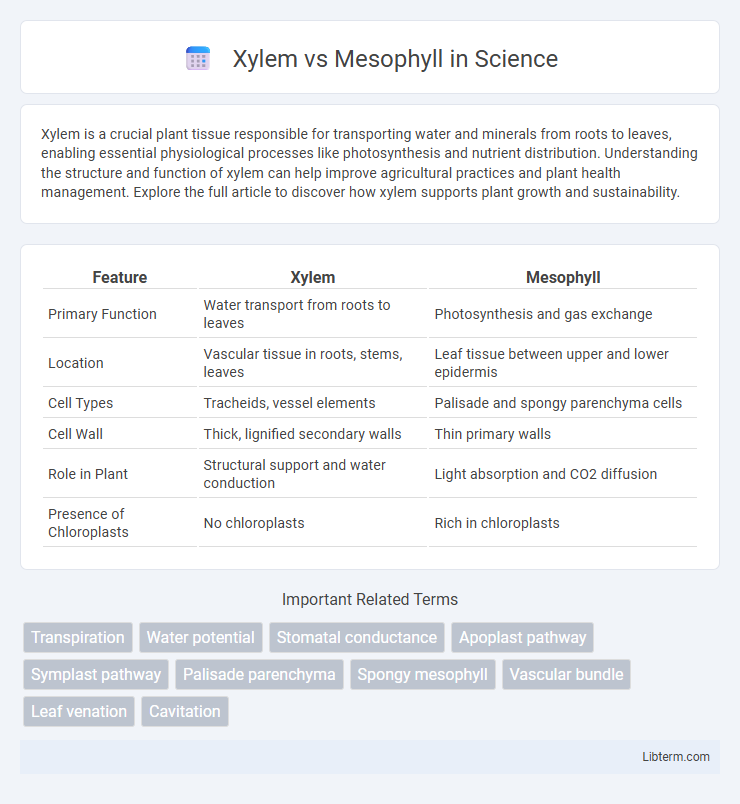Xylem is a crucial plant tissue responsible for transporting water and minerals from roots to leaves, enabling essential physiological processes like photosynthesis and nutrient distribution. Understanding the structure and function of xylem can help improve agricultural practices and plant health management. Explore the full article to discover how xylem supports plant growth and sustainability.
Table of Comparison
| Feature | Xylem | Mesophyll |
|---|---|---|
| Primary Function | Water transport from roots to leaves | Photosynthesis and gas exchange |
| Location | Vascular tissue in roots, stems, leaves | Leaf tissue between upper and lower epidermis |
| Cell Types | Tracheids, vessel elements | Palisade and spongy parenchyma cells |
| Cell Wall | Thick, lignified secondary walls | Thin primary walls |
| Role in Plant | Structural support and water conduction | Light absorption and CO2 diffusion |
| Presence of Chloroplasts | No chloroplasts | Rich in chloroplasts |
Introduction to Xylem and Mesophyll
Xylem is a vascular tissue in plants responsible for transporting water and dissolved minerals from roots to aerial parts, playing a crucial role in maintaining plant hydration and nutrient supply. Mesophyll is the inner tissue of a leaf where photosynthesis primarily occurs, consisting of palisade and spongy cells that optimize light absorption and gas exchange. Both structures are essential for plant survival, with xylem supporting water transport and mesophyll facilitating energy conversion through photosynthesis.
Definition and Structure of Xylem
Xylem is a type of vascular tissue in plants responsible for the transport of water and minerals from roots to other parts of the plant, characterized by lignified, tubular vessels and tracheids that provide structural support. Mesophyll, in contrast, is the inner tissue of a leaf composed mainly of parenchyma cells, specialized for photosynthesis and gas exchange. The rigid structure of xylem, formed by dead cells arranged in continuous ducts, contrasts with the living, loosely packed mesophyll cells designed to maximize light absorption and carbon dioxide diffusion.
Definition and Structure of Mesophyll
Mesophyll is the inner tissue of a leaf, primarily responsible for photosynthesis, consisting mainly of two types: palisade and spongy parenchyma cells. These cells contain numerous chloroplasts to capture light energy, with palisade mesophyll having elongated cells tightly packed to maximize light absorption, while spongy mesophyll has loosely arranged cells with air spaces to facilitate gas exchange. Unlike xylem, which is a vascular tissue conducting water and minerals from roots to leaves through vessels and tracheids, mesophyll lacks vascular structure and functions mainly in metabolic processes within the leaf.
Primary Functions of Xylem
Xylem primarily functions in the transportation of water and dissolved minerals from the roots to the rest of the plant, facilitating essential nutrient distribution. It also provides structural support due to its lignified cell walls, enabling plants to maintain rigidity and stand upright. Unlike mesophyll, which is involved in photosynthesis, xylem's key role lies in sustaining water flow and mechanical strength.
Primary Roles of Mesophyll
Mesophyll primarily facilitates photosynthesis by housing chloroplasts that convert light energy into chemical energy, essential for plant growth and metabolism. It consists of two layers, palisade and spongy mesophyll, which optimize light absorption and gas exchange through stomata. Unlike xylem, which mainly transports water and minerals from roots to leaves, mesophyll cells actively produce glucose and oxygen, supporting overall plant vitality.
Key Differences Between Xylem and Mesophyll
Xylem primarily functions in the transport of water and minerals from roots to the rest of the plant, consisting of vessels and tracheids that form a continuous network. Mesophyll, located within leaf tissue, specializes in photosynthesis, containing chloroplast-rich cells that capture light energy and facilitate gas exchange. Unlike xylem's rigid, lignified structure for conduction, mesophyll cells are softer and adapted for optimizing light absorption and carbon dioxide diffusion.
Xylem in Water and Nutrient Transport
Xylem is a specialized vascular tissue responsible for transporting water and dissolved minerals from roots to leaves in plants, playing a crucial role in maintaining hydration and nutrient distribution. It consists of tracheids and vessel elements that create continuous tubes facilitating efficient water movement through capillary action and transpiration pull. Unlike mesophyll, which primarily engages in photosynthesis, xylem ensures the essential supply of water and nutrients necessary for metabolic processes throughout the plant.
Mesophyll in Photosynthesis Process
Mesophyll cells in plant leaves are the primary site of photosynthesis, containing abundant chloroplasts where light energy is converted into chemical energy. Unlike xylem, which transports water and minerals, mesophyll facilitates gas exchange and carbon dioxide fixation through the Calvin cycle. The spongy and palisade mesophyll layers optimize light absorption and CO2 diffusion, essential for synthesizing glucose during photosynthesis.
Importance of Xylem and Mesophyll in Plant Health
Xylem plays a critical role in plant health by transporting water and essential minerals from roots to leaves, enabling photosynthesis and nutrient distribution. Mesophyll tissue, primarily found in leaves, facilitates gas exchange and houses chloroplasts where photosynthesis occurs, producing energy vital for growth. Both xylem and mesophyll are indispensable for maintaining water balance, nutrient transport, and energy production necessary for overall plant vitality and development.
Summary: Xylem vs Mesophyll Comparison
Xylem transports water and minerals from roots to leaves, playing a vital role in plant hydration and nutrient distribution. Mesophyll consists of chloroplast-rich cells in leaves responsible for photosynthesis and gas exchange. The primary difference lies in function: xylem supports fluid movement, while mesophyll facilitates energy production and respiration.
Xylem Infographic

 libterm.com
libterm.com